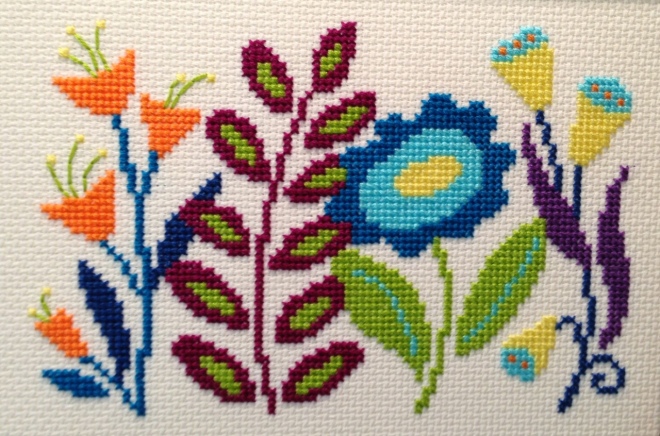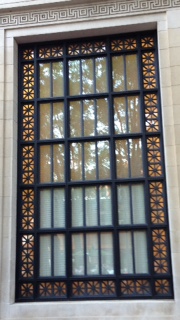By Anna Bernard, Summer Intern

Anna Bernard
As part of the launch of Star Stitch’s new blog, we’re conducting Q&As with each of our authors. Today, we’re talking with Vickie LoPiccolo Jennett, whose book Sonoran Borders: Threads of Friendship is available now.
Vickie has been writing as long as she can remember. Her fascination with words and alphabets began in nursery school, where she carried a letter-covered felt book bag. Penmanship was one of her favorite subjects in grade school.
Writing in high school and college led to a journalism career. Vickie’s passion is researching and writing about antique needlework. Her articles have appeared in many needlework magazines, including Sampler & Antique Needlework Quarterly and Just Cross Stitch.
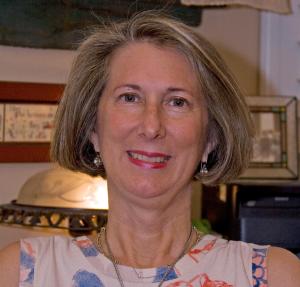
Vickie LoPiccolo Jennett
She and her daughter-in-law Maegan Jennett are partners in NeedleWorkPress, a home-based business dedicated to preserving and presenting printed materials related to historic needlework. The name NeedleWorkPress incorporates the first initials of her husband’s and sons’ names: Niles, Willy and Patrick.
Vickie’s house and the home of NeedleWorkPress is a replica of a 19th century farmhouse in the country just outside of Phoenix, where she and Niles raised two sons, countless calves and a couple of pygmy goats.
Vickie says she is best characterized by the sentiment stitched on a sampler in her living room: “My faith, my family and my friends bring meaning to my life.”
***
How did you get started cross stitching?
I guess I can thank my wool allergies for the switch from needlepoint to cross stitch. I learned to work on canvas as a preteen, but soon ended up with splotchy hands due to my allergies. Stamped embroidery was a staple in our home, too.
As with many stitchers, my first projects were rather underwhelming, although I do recall making a valentine heart for my high school sweetheart, who is now my husband. As a klutz with most athletic endeavors, I found handwork to be a relaxing pastime. I stitched in the car to and from the long drives to horse shows during high school.
To this day, people outside the stitching world are surprised that I enjoy such a sedentary pastime because unless I’m stitching, I pretty much don’t sit still.
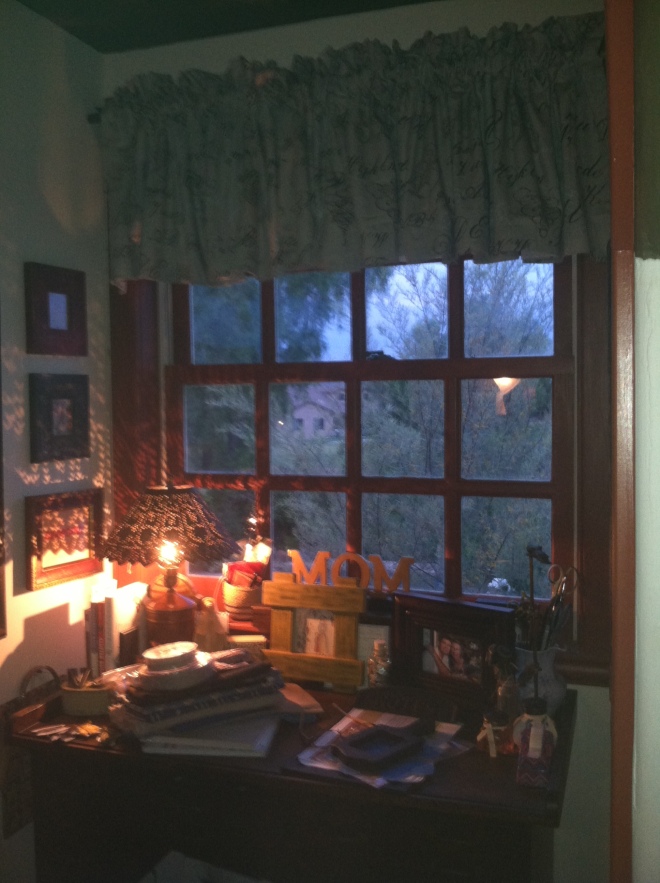
Vickie’s work station.
Do you have a special place where you cross stitch?
Yes and no. My favorite place to stitch is in our living room, the one room in the house that’s pretty much always in some semblance of order. However, most of my stitching is done on the run: in airports, during boring meetings, at sports competitions, when I’m a passenger in the car, at seminars, while watching shows pre-recorded on our DVR. I carry cross stitch projects with me everywhere and they’re scattered throughout the house.

Vickie with her husband and grandson.
Do you have a schedule?
I wish. My most productive hours are early morning. Since my dairy-vet husband is up and out of the house before the sun rises, I usually get up at 5:30 and work on the project du jour. I feel best when that routine includes exercise, but too many writing and stitching deadlines make me a sloth.
I do get in a yoga workout or two every week. Then, it’s go, go, go until evening, when Niles and I half-watch recorded TV favorites while I stitch and he catches up on the day’s emails.
What are your favorite and least favorite parts of cross stitch?
Cross stitch is sheer bliss! Every single project amazes me as “something” emerges from “nothing” with simple x’s on linen. The only detracting factor is ripping. Oh, and my eyes. Until recently, I didn’t need readers. They’re annoying. I’ve found cute ones, however, so that helps make up for the annoyance.
What cross stitch patterns are you most drawn to?
Antique samplers, especially those with alphabets and cows, are my weakness. I do enjoy a bit of whimsy in warm, primitive designs, as well as clever verses. I have more projects stashed away that I could complete in a dozen lifetimes. Perhaps dreaming about accomplishing these projects is as much fun as completing them.
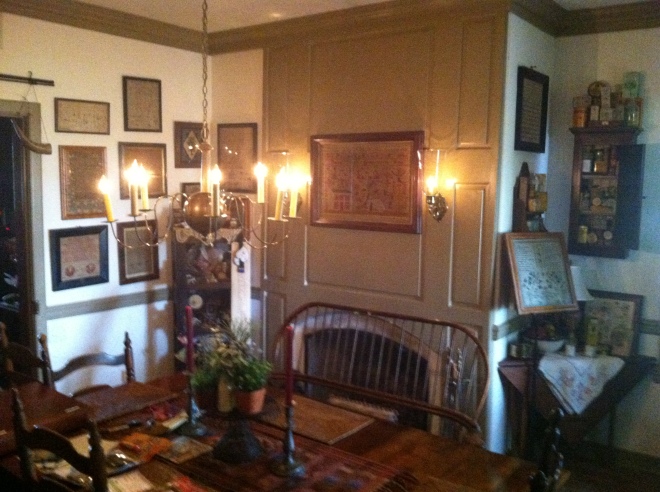
Vickie’s sources of inspiration in her dining room.
What other creative outlets do you have?
We live in the replica of a 19th century farmhouse and both Niles and I enjoy collecting antiques, although Niles has recently asked me if I care to audition for an episode of “Hoarders.”
Tending flowers and herbs in the back yard is another passion. I have been known to tear up when a plant freezes in the winter. Fortunately, that doesn’t happen every year.

Vickie’s back gate.
Any words of wisdom for someone just starting to cross stitch? What’s the best advice you received?
Find a cross stitch chart you adore. What subject matter really excites you? Make sure your selection isn’t overwhelming. Have fun. Only tackle a project if it speaks to you. Don’t worry about perfection first time around – or ever, really.
Years after I finished and framed one of my favorite reproduction samplers, I noticed that I forgot flowers in one of the matching urns. Too late. Idiosyncrasies make each piece unique – or at least that’s what I tell myself.

Watering her many plants is a morning ritual.
Is there any needlework you haven’t done that you would like to try?
I haven’t stitched on 50ct linen, but I would really like to try it to see if my eyes will adjust. I’m just learning to hem stitch. It’s not difficult; just scary to be at the end of a project, then to have to pull threads and stitch all around the project. I think next time, I’ll do the hem stitching first.
Actually, with needlework and life in general, both education and experience continue to teach me that the more I learn, the more I realize how little I actually know and how much there is to learn. This might sound trite and corny, but I’m sincere when I say that trying new things and learning new ideas make every day exciting.
What’s your next project?
We’re working on a series of alphabet samplers called “Minerva and Friends.” They’re simple marking samplers, each with their own charm. One is a monochrome blue; one has the wise words, “Waste not, want not.”
Maegan and I also are so excited about progress on our next book for Kansas City Star Quilts. It’s based on a beautiful blue 19th century 18” x 18” handkerchief and has the working title of A Schoolroom Alphabet, with a tentative release date of February 2014. For fun stitching, my UFO bags and baskets are overflowing with favorite projects, including the Scarlet Letter’s “Ruthy Rogers” and the Examplarey’s “Frances Pyrault Sampler.”
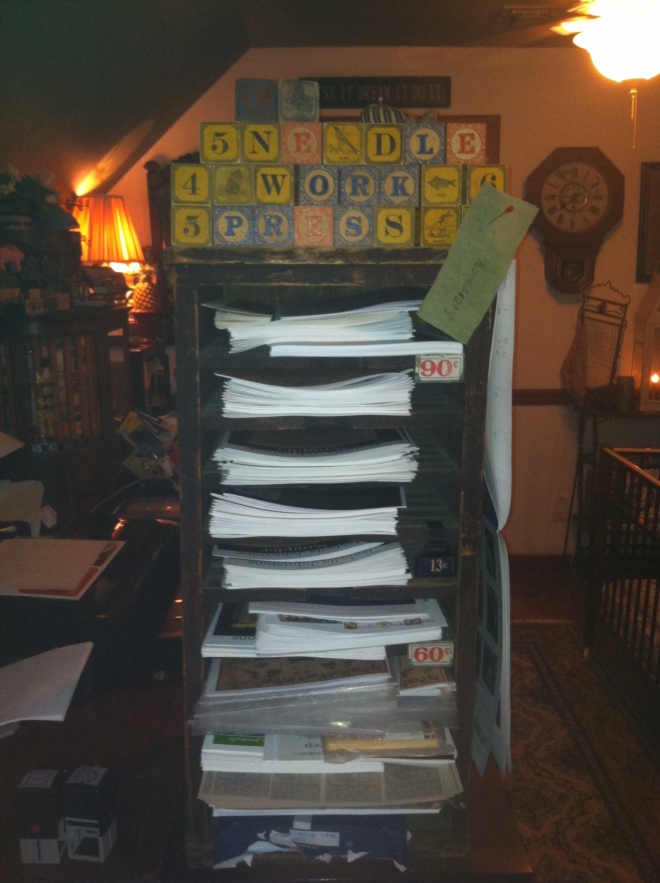
Vickie’s storage space.
What was your favorite part about writing your cross stitch book?
The process, the entire process: from conception through completion. I hardly equate my work to the amazing and prolific Larry McMurtry, but I wholeheartedly agree with a comment he made in Literary Life: A Second Memoir: “I had expected to be thrilled when I received my first copy of my first book, but when I opened the package and held the first copy in my hand, I found that I just felt sort of flat … . I learned then and have relearned many times since, that the best part of a writer’s life is actually doing it, making up characters, filling the blank page, creating scenes …”
The process was just amazing, all-consuming at times. While I sure don’t mind giving up my regular workouts so I could lavish time on the book, my clothes are groaning as they burst at the seams.
Throughout the process, my gratitude continued to go out first to everyone who helped birth this project and next to the readers who are taking the time to let me know that this little story and these humble projects truly have touched their spirits. Can a writer want more than that? I think not.
How do you connect with other cross stitchers?
NeedleWorkPress maintains a Web site and we try to post new products, ideas, photos and information a couple of times a month. We love teaching and talking about needlework to guilds and groups of all kinds, including schools. Our goal is to get more children and young adults interested in the gentle arts.
When time permits, we gather in a friend’s backyard for some stitching and conversation. This usually includes chocolate in some form or another. I also write articles for several needlework magazines.





